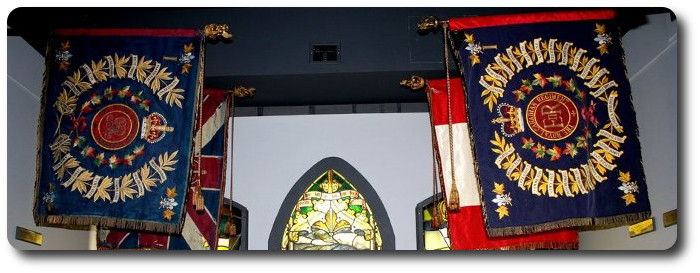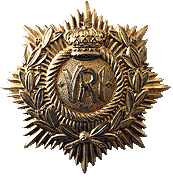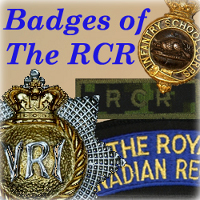
Researching The Royal Canadian Regiment

The Royal Canadian Regiment in Halifax
April 1898 - No. 4 Company in Fredericton is relieved by a company of the Royal Berkshire Regiment in order that No. 4 Coy The RCR might proceed to Halifax to study battalion organization and the duties which the garrisoning of an important station involved. The attachment was for a six month period. (1, pp 54)
Oct 1899 - "H" Coy, the 2nd (Special Service) Battalion, Royal Canadian Regiment is recruited in Nova Scotia for service in South Africa. (1, pp 87)
27 Feb 1900 - "H" Coy (along with "G" Coy) distinguishes herself at Paardeburg. (1, pp 115)
Mar 1900 - The 3rd (Special Service) Battalion, Royal Canadian Regiment (29-87-888) is recruited under the temporary command of Colonel B.H. Vidal to garrison Halifax, releasing the 1st Battalion, Prince of Wales' Leinster Regiment (Royal Canadians) for service in South Africa. (1, pp 158)
1 Oct, 1900 - The first returning draft (16 officers and 430 other ranks) embarks at Cape Town, aboard the S.S. Idaho for Halifax. (1, pp 149)
23 Dec, 1900 - The remainder of the 2nd Battalion reaches Halifax aboard the Lake Champlain from England. (1, pp 156)
Sept 27, 1901 - Orders are received to disband the 3rd Battalion as their replacements, the 5th Battalion, Royal Garrison Regiment, waits aboard ship in Halifax Harbour. The battalion executed the order to disband by 29 Sept. The official disbandment of the unit was effected with General Order No. 107 on Oct 1, 1902. (1, pp 160)
May 1905 - Regimental Order No. 328 gave preliminary instructions for the relief of the British troops in Halifax. Summarized, the orders were that on May 23, an advance party composed of 1 officer, 2 non-commissioned officers and 8 privates would proceed to Halifax, report to the Deputy Assistant Adjutant-General, and take over the quarters (Glacis Barracks) which the Regiment would occupy. Two days later, the advance party would be followed by a detachment [commanded by Major and Brevet Lieut.-Col. R.L. Wadmore.] (1, pp 172-3)
1905 - By the autumn of 1905, Halifax was garrisoned by the Regimental H.Q. and Nos. 1 to 6 Companies of The RCR. A Regimental band (of 25 all ranks) had also been constituted. Lieut.-Col. Wadmore was appointed to regimental command from 15 Sept 1905. (1, pp 174-5)
Jan 1907 - It is announced that alphabetical designations for the companies would be adopted. Stationed at Halifax were;
a. "A" Coy, formerly No. 4 Coy;
b. "B" Coy, formerly No. 3 Coy;
c. "C" Coy, formerly No. 2 Coy;
d. "D" Coy, formerly No. 1 Coy;
e. "E" Coy, formerly No. 5 Coy;
f. "F" Coy, formerly No. 6 Coy. (1, pp 177-8)
1908 - The authorized strength of H.Q. and No. 4 Regimental Depot (Halifax) was 600 of the Regimental strength of 930. (1, pp 179)
July 8, 1909 - 250 of the RCR, with 200 garrison artillery and 50 engineers deploy from Halifax to Glace Bay for strike duty until 4 March, 1910. (1, pp 183)
Feb 27, 1913 - A dinner to commemorate the Battle of Paardeburg was held at the Queen's Hotel. (1, pp 192)
Apr 27, 1913 - The March of the Lone Baptist.
"As the Headquarters' file of Regimental Orders for 1913 and most of 1914 was destroyed in the Halifax explosion in 1917, and as a prolonged search has failed to discover copies in Ottawa, or at any of the Regimental Depots, the exact sequence of events in this period is now difficult to ascertain, but, thanks to private diaries and similar memoranda, a record of some incidents has been preserved. There was, for example, the March of the Lone Baptist, an event unparalleled in the Regiment's, or perhaps any other regiment's, history.
From the time when the unit assumed garrison duties in Halifax in 1905, it had been the custom of the band to march in the church parades of the Church of England, Presbyterian and Roman Catholic detachments in rotation, leaving the smaller denominations to proceed without musical accompaniment. On the complaint of certain Ministers in Halifax against what they considered unfair discrimination, the Honourable the Minister of Militia and Defence ruled that all denominations must be treated alike and that the band must accompany each detachment in turn. In accordance with these orders, Sunday, April 27, was allotted to the Baptist denomination. There were three Baptists serving in the Regiment in Halifax at the time, two of whom were on detached duty, but the orders were explicit. Accordingly, the lone Baptist was paraded, Lieut. H.T. Cock assumed command of the parade, the Regimental Sergeant-Major took his appointed post, two police joined the detachment as usual, the band of approximately 40 pieces struck up an appropriate air, and off the Baptist was marched to his place of worship more than a mile away. Flattering as the escort must have been, the service would have seemed to have displeased him. No exact explanation is now available, but it is on record that he paraded before the Commanding Officer and changed his religion on the following day, an example which the adherents of other minor denominations were prompt to follow. (1, pp 192)
July 31, 1914 - The RCR deploys to defensive points in Halifax Fortress and No. 6 Canadian Divisional Military Area;
a. "A" Coy, Sandwich Battery in Halifax Harbour (1 km south of York Redoubt);
b. "B" Coy, Sydney and North Sydney;
c. "C" Coy, half as Detaining Unit, Wellington Barracks, half to Camperdown Signal Station, Halifax;
d. "D" Coy, Halifax Fortress;
e. "E" Coy, Canso;
f. "F" Coy, McNab's (harbour mouth) and Lawlor's (Eastern Passage) Islands. (1, pp 198-9)
Aug 4, 1914 - "I" Coy (Toronto) and "K" Coy (London) proceed to Halifax. (1, pp 199)
Aug 5, 1914 - "C" Coy deploys to Louisbourg, "F" Coy to Long and Chain Lakes to guard the city's water supply, "I" and "K" Coys replace "F" Coy on the harbour islands. (1, pp 199)
Aug 20, 1914 - The RCR are called to duty in Bermuda. (1, pp 200)
Aug 29, 1914 - Headquarters is relieved at York Redoubt and moved back to Wellington Barracks, "B" Coy returns from Sydney. (1, pp 200)
Aug 30, 1914 - The RCR parades for inspection by Field-Marshal His Royal Highness the Duke of Connaught, Governor-General of Canada and Commander in Chief of the Dominion's Forces, "H" Coy (Fredericton) arrives in Halifax. (1, pp 200-1)
Sept 4, 1914 - "G" Coy (Quebec) arrives in Halifax. (1, pp 200)
Sept 10, 1914 - The battalion paraded with a strength of 1,020 all ranks and, led by the pipers of the Canadian Garrison Artillery, marched to the waterfront, where it embarked on the Canada, which lay awaiting it. On the following day at noon, as the troops sang "Tipperary" on deck, the Canada sailed for Bermuda. A Regimental Depot remained in Halifax. (1, pp 201-2)
Aug 13, 1915 - Upon relief by the 38th Battalion C.E.F., The RCR embarked on the Caledonian, arriving in Halifax four days later. All ranks then disembarked and marched to billets in the Armouries, or in tents on the common outside. (1, pp 209)
Aug 26, 1915 - The RCR, re-embarked on the Caledonian, sail for England. (1, pp 211)
Dec 1917- On December 6, 1917 when the explosion of the munitions ship Mont Blanc devastated Halifax, [the Regimental colours] were buried under the ruins of the Officers' mess at Wellington Barracks. Some days later, tattered and coated in snow and ice, they were recovered and restored to safety. (1, pp 164-5)
Mar 9, 1919 - The RCR arrives off Halifax in the Adriatic. With "D" Coy leading, the Regiment, with a party of approximately 100 returned casualties attached, marched out Oxford Street, down Spring Garden Road, and back to the hutments on the Common. There, upon the command, "Dismiss", the [Overseas Battalion] broke ranks forever. (1, pp 382-3)
Apr 3, 1919 - The Regimental Base Depot in Halifax issues Daily Order No. 1, thus marking the Regiment's return to duty in the Permanent Force. Throughout the summer of 1919, the whole Regiment remained in Halifax, but in the autumn "D" Coy was dispatched to re-establish a Regimental station in Montreal. (1, pp 388-9)
1920 - Changes to the Regimental structure and stations see only "A" Coy remaining in Halifax by the end of 1920. The remainder of the Regiment has established barracks in London (H.Q. and "C" Coy), Toronto ("B" Coy), and Montreal ("D" Coy). (1, pp 392-3)
1927 - A detachment of the Regiment appeared in full dress for the first time since the Great War, this took place in Halifax in honour of the Dominion's 60th anniversary. (1, pp 400)
1931 - As the year 1931 approached its end, "A" Coy was ordered to evacuate the Citadel in Halifax and take quarters in Wellington Barracks, a move of more than usual historic interest, as it marked the first occasion since 1778, so far as can be ascertained, upon which the Citadel was left without a British or Canadian garrison. (1, pp 406-7)
1933 (autumn) - A banner presented to the Regiment by His Majesty King George V to commemorate the services of its Expeditionary Force battalion in the Great War was deposited in St. Mark's Church, Halifax. (1, pp 408)
1933 - Each company was stationed in a different environment. Halifax had been a garrison town for centuries; soldiers had their place in the community. "A" Company no longer occupied the Citadel but had shifted to Wellington Barracks. (2, pp 2)
1936 - Later in the year [sometime after May] the [Regimental] band travelled to Halifax to play at the Nova Scotia Exhibition. (2, pp 8)
Dec 17/18, 1939 - The RCR arrived in Halifax and embarked on the HMT Almanzora, a Royal Mail Liner. The Regimental birthday was celebrated at anchor and the convoy sailed the following day (Dec 22). (2, pp 16)
Sept 29, 1945 - The Netherlands liner Nieuw Amsterdam arrives in Halifax bearing The RCR, the Regiment entrained immediately for London. (2, pp 198)
1949 (late May) - A Guard of honour 100 strong flew from Ottawa to Halifax to participate in the bi-centennial celebrations of Nova Scotia. (2, pp 206)
1961 - The Halifax branch of the Regimental Old Comrades Association is "resuscitated." (2, pp 351)
15 July 1983 - 2RCR is granted The Freedom of the City of Halifax. (3)
17 July 1983 - 2RCR Trooping of the Colours in Halifax. (3)
Dec 23, 1993 - A Regimental funeral party from the 2nd Battalion (Gagetown) attends the Halifax funeral of [Pte.] Sydney Jones, Nova Scotia's last surviving black veteran of the First World War. Pte Jones was serving with the Regiment when he was wounded at Passchendaele, Belgium, during the Third Battle of Ypres. (4)
Apr 29, 1995 - The officers of The regiment stationed in Halifax host a retirement Mess Dinner for Col Bruce Gilchrist and LCol Dick Gray. This dinner, by the gracious permission of Parks Canada, is held in the Cavalier Block within the walls of the Halifax Citadel Fortress.
References:
1. The Royal Canadian Regiment, 1883-1933, R.C. Fetherstonhaugh, 1936
2. The Royal Canadian Regiment, Volume 2 1933-1966, G.R. Stevens, OBE, LL.D., 1967
3. The Regimental Calendar - 1986
4. The Chronicle-Herald/Mail Star, Thursday December 23, 1993


